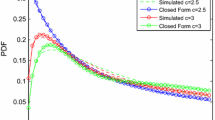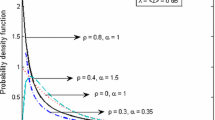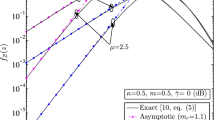Abstract
A compound fading model incorporating short term fading and shadowing proposed recently is used to analyze the performance of wireless systems employing microscopic diversity to mitigate the effects of flat fading. This model can account for the presence of different levels of fading and shadowing and provide an analytical solution for the probability density function of the signal-to-noise ratio. Using that model, the performances of MRC and SC diversity combining algorithms were studied. The amount fading (AF) following diversity implementation was calculated and it is seen that the decline in the amount of fading is bound by the level of shadowing present, with the MRC providing a larger decrease in the amount of fading than the SC algorithm. The effect on the error rates was studied using the example of the coherent BPSK modem. Results show that the performances of wireless systems can be analyzed using the compound model for the shadowed fading channels.
Similar content being viewed by others
References
M.K. Simon and M.-S. Alouni, Digital Communication over Fading Channels: A Unified Approach to Performance Analysis, John Wiley & Sons Inc., New York, 2000.
M. Nakagami, “The m Distribution. A General Formula for Intensity Distribution of Rapid Fading”, in W. C. Hoffman (ed.), Statistical Methods in Radio wave Propagation, New York, Pergamon, 1960.
F. Hansen and F.I Mano, “Mobile Fading-Rayleigh and Lognormal Superimposed”, IEEE Trans. Vehic. Tech., Vol. 26, pp. 332–335, 1977.
H. Suzuki, “A Statistical Model for Urban Radio Propagation”, IEEE Trans. Comm., Vol. 25, pp. 673–680, 1977.
A.A. Abu-Dayya and N.C. Beaulieu, “Performance of Micro- and Macro Diversity on Shadowed Nakagami Fading Channels”, Proc. GLOBE' 91, Vol. 2, pp. 1121–1124, 1991.
T.T. Tjhung and C.C. Chai, “Distribution of SIR and Performance of DS-CDMA Systems in Lognormally Shadowed Rician Channels”, IEEE Trans. on Veh. Tech., Vol. 49, pp. 1110–1125, 2000.
R. Vaughn and J.B. Andersen., “Channels, Propagation and Antennas for Mobile Communications”, IEE, London, U.K., 2003.
E.K. Al-Hussaini, A.M. Al-Bassiouni, H. Mouradand, and H. Al-Shennawy, “Composite Macroscopic and Microscopic Diversity of Sectorized Macrocellular and Microcellular Mobile Radio Systems Employing RAKE Receiver Over Nakagami Fading Plus Lognormal Shadowing Channel”, Wireless Personal Communications, Vol. 21, pp. 309–328, 2002.
A. Abdi and M. Kaveh, “Comparison of DPSK and MSK Bit Error Rates for K and Rayleigh-Lognormal Fading Channels”, IEEE Comm. Lett., Vol. 4, pp. 122–124, 2000.
J.-C. Lin, W.-C. Kao, Y.T. Su, and T.H. Lee, “Outage and Coverage Considerations for Microcellular Mobile Systems in a Shadowed-Rician/Shadowed Nakagami Environment”, IEEE Trans. on Vehic. Tech., Vol. 48, pp. 66–75, 1999.
J.E. Tighe, I. Karagiannis, J. Lebaric, and T.T. Ha, “Performance of DS-CDMA Cellular Forward Channel with Nakagami-Square-Lognormal Fading Model”, WCNC, pp. 178–183, 2003.
W. Roh and A. Paulraj, “MIMO Channel Capacity for the Distributed Antenna Systems”, Proceedings VTC 2002-Fall, Vol. 2, pp. 1520–1524, 2002.
P.M. Shankar, “Error Rates in Generalized Shadowed Fading Channels”, Wireless Personal Communications, Vol. 28, pp. 233–238, 2004.
D.J. Lewinsky, “Nonstationary Probabilistic Target and Cluttering Scattering Models”, IEEE Trans. on AES, Vol. 31, pp. 490–498, 1983.
V. Anastassopoulos, V.G.A. Lampropoulos, A. Drosopoulos, and M. Rey, “High Resolution Radar Clutter Statistics”, IEEE Trans. on AES, Vol. 35, pp. 43–60, 1999.
M. Gu and D.A. Abraham, “Using McDaniel's Model to Represent Non-Rayleigh Reverberation”, IEEE Trans. on Oceanic Engg., Vol. 26, pp. 348–357, 2001.
A. Abdi and M. Kaveh, “On the Utility of Gamma pdf in Modeling Shadow Fading (Slow Fading)”, in Proc. IEEE Vehicular Technology Conf., Houston, TX, pp. 2308–2312, 1999.
S.T. McDaniel, “Seafloor Reverberation Fluctuations”, J. Acoust. Soc. Amer., Vol. 88, pp. 1530–1535, 1990.
I.S. Gradsheteyn and I.M. Ryzhik, Table of Integrals, Series, and Products, Academic, New York, 1994.
D.G. Brennan, “Linear Diversity Combining Techniques”, Proc. IRE, Vol. 47, pp. 1075–1102, June 1959.
T. Eng, N. Kong, and L.B. Milstein, “Comparison of Diversity Combining Techniques for Rayleigh-Fading Channels”, IEEE Trans. on Comm. Vol. 44, No. 9, pp. 1117–1129, September 1996.
V.A. Aalo and J. Zhang, “Performance Analysis of Maximal Ratio Combining in the Presence of Multiple Equal Power Co-Channel Interferers in a Nakagami Fading Channel”, IEEE Trans. on Veh. Tech., Vol. 50, pp. 497–503, 2001.
O.C. Ugweje and J.E. Grover, “Diversity Performance of DS-CDMA Communication System on Nakagami Fading with Arbitrary Parameters”, Computers and Electrical Engineering, Vol. 28, pp. 25–42, 2002.
MATLAB, Version 6.5, Release13, The MathWorks, Inc., Natick, MA, 2002.
M. Ohta and T. Koizumi, “Intensity Fluctuation of Stationary Random Noise Containing an Arbitrary Signal Wave”, IEEE, Vol. 57, pp. 1231–1232, 1969.
J.R. Clark and S. Karp, “Approximations for Lognormally Fading Optical Signals”, Proc. IEEE, Vol. 58, pp. 1964–1965, 1970.
Author information
Authors and Affiliations
Corresponding author
Additional information
P.M. Shankar received his M. Sc (1972) in Physics from Kerala University, India, M. Tech (1975) in Applied Optics and Ph. D. in Electrical Engineering (1980) from Indian Institute of Technology, Delhi, India. He was a visiting scholar at the School of Electrical Engineering, University of Sydney, Australia, from 1981 to 1982. He joined Drexel University in 1982 and is currently the Allen Rothwarf Professor of Electrical and Computer Engineering. He is the author of the textbook ‘Introduction to Wireless Systems’, published by John Wiley & Sons, 2002. His research interests are in Fading Channels, Wireless communications, and Statistical signal processing for medical applications.
Rights and permissions
About this article
Cite this article
Shankar, P.M. Performance Analysis of Diversity Combining Algorithms in Shadowed Fading Channels. Wireless Pers Commun 37, 61–72 (2006). https://doi.org/10.1007/s11277-006-1080-9
Issue Date:
DOI: https://doi.org/10.1007/s11277-006-1080-9




